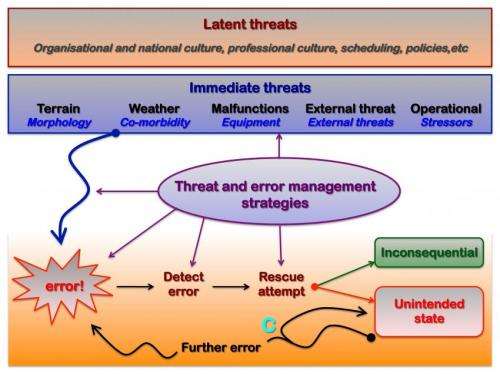Applying lessons from NASA helps manage threats and errors in pediatric cardiac surgery

All high-stakes industries that function at very high "6-sigma" safety levels have a pre-occupation with human error. The aviation industry epitomizes this concept; during the 1970s NASA and aviation researchers realized that humans are the least reliable resource in the cockpit. Subsequent research into >30,000 flights has confirmed that human error is inevitable, ubiquitous, and therefore needs to be understood and managed. Mismanaged error leads to cycles of further error and unintended states, with consequent loss of safety margins.
Using their experience with aviation errors, NASA/FAA researchers generated a "threat and error model." Now, researchers have applied this "threat and error model" to a pediatric cardiac surgery program. Edward J. Hickey, MD, a cardiac surgeon at The Labatt Family Heart Centre, The Hospital for Sick Children, Toronto, Canada, is presenting the results of his department's experience at the 94th AATS Annual Meeting in Toronto, ON, Canada, on April 28, 2014.
"We considered every patient's peri-operative journey to be a 'flight,' and we tracked it from patient arrival in the operating room until the point of discharge, with the aim of identifying 'threats,' 'errors,' unintended clinical states, and harmful outcomes," says Dr. Hickey. He reports on the results of "flight tracking" for the first 500 consecutive patients admitted for pediatric heart surgery (85% utilizing cardiopulmonary bypass).
Among the 524 "patient flights" that these 500 pediatric cardiac patients experienced, 763 threats were identified. More than 85% of threats were end-organ dysfunction, non-cardiac congenital lesions, and unusual or complex variants of a particular lesion type. "We saw that almost all threats were apparent before the flight had begun," comments Dr. Hickey.
The researchers found that only 50% of patient flights were error-free. Most errors, which were related to "proficiency" or "judgment," were consequential in that they led to an unintended clinical state. Over 60% of consequential errors (~20% of all patient flights) led to cycles of additional error and unintended state – i.e. progressive loss of safety margins. Such cycles were very significantly associated with harmful patient outcomes, such as brain injury, residual cardiovascular lesions, or death. Deaths were almost always preceded by error cycles.
"We conclude that the progressive degradation of safety margins that occurs in most aviation disasters, and I use Air France 447 as an example, has direct corollaries in medicine," states Dr. Hickey. He and his co-investigators suggest that error needs to be expected, better understood, and better managed, and that heightened levels of vigilance are essential for prompt error detection. They believe that optimizing communication and resource utilization during unexpected deviations from the planned clinical journey (using techniques similar to "Crew Resource Management" in commercial aviation training) will likely improve error rescue and have a positive impact on patient outcomes.
More information: "NASA 'threat and error model' applied to pediatric cardiac surgery: Error cycles precede ~85% of patient deaths," by Edward J Hickey, Yaroslavna Nosikova, Eric Pham-Hung, Michael Gritti, Steven Schwartz, Christopher A Caldarone, Andrew Redington, and Glen S Van Arsdell. Presentation at the 94th AATS Annual Meeting. April 26-30, 2014. Toronto, ON, Canada, during the Plenary Scientific Session on April 28, 8:10 AM ET. aats.org/annualmeeting

















